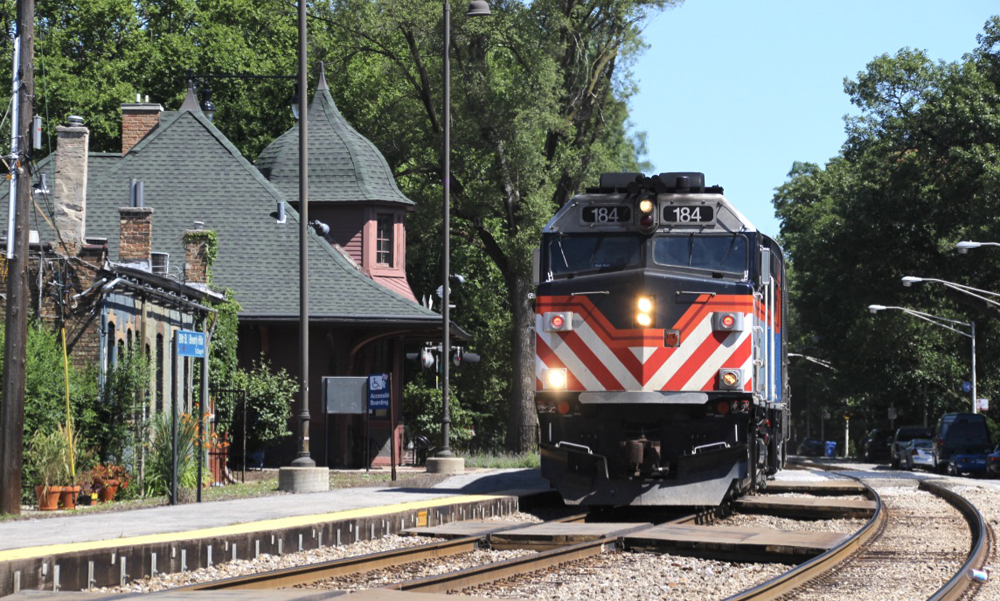
CHICAGO — More than a year after requesting proposals for the project, Metra’s board of directors has approved a plan to convert at least three of its oldest F40PH-3 locomotives, and as many as six, to battery power.

Progress Rail will perform the conversions at its Patterson, Ga., facility, with delivery of the initial order of three locomotives expected to take about 3½ years. There are also options for three more locomotives; total cost of the six-locomotive order is $34.6 million.
“This procurement puts Metra on the cutting edge of battery-powered technology and demonstrates our commitment to innovation and cleaner energy,” Metra CEO/Executive Director Jim Derwinski said in a press release. “If these locomotives prove themselves, they could play a significant role in our fleet and in our future, and the concept could serve as a template for other railroads to follow.”
The request for proposals issued in 2021 requires the locomotives to be compatible with all existing Metra equipment, capable of hauling 11 cars at up to 79 mph, and powering those cars’ onboard lighting, heating and cooling, and intercom systems [see “Metra seeks to convert three diesels to battery power,” Trains News Wire, April 23, 2021].
The locomotives are expected to have a range of about 150 miles; plans are to test them on Metra’s Rock Island District. That line includes the unique Beverly Branch operation, a relatively short, frequent-stop operation (15.7 miles, 15 stations between La Salle Street in downtown Chicago to Vermont Avenue in Blue island) that may be particularly well suited to the testing. The full Rock Island District runs 40 miles to Joliet, Ill. Charging stations, to be designed after the locomotive design is set, will be placed at Metra’s 47th Street Yard and outlying locations.
The battery locomotives are one of three initiatives to update Metra’s motive-power fleet to address diesel emissions. Others involve plans to purchase six switch engines that met Environmental Protection Agency Tier IV emission standards, and an order for 15 remanufactured EMD SD70MACH locomotives from Progress Rail that will meet Tier 3 standards, with options for 27 others. Those locomotives were ordered in 2019 [see “Update: Metra board approves locomotive purchase …,” News Wire, Feb. 20, 2019]; Metra says the first is expected to be delivered this year.













I hope there is a provision in the contract that Metra gets all of their money back when they find out this battery crap doesn’t work. We’ve all seen the hype for battery powered locomotives, followed by a grand media event after the first locomotive is delivered. But usually within 2-3 years, they quietly have quit working & are sidelined. I suspect this venture will be no different than any of the preceding attempts.
Can someone expalin why pulling a prime mover and putting in batteries costs $6m?
If Senator Reed hadn’t gotten his knickers in a knot over the long term nuclear storage facility in HIS state (NV) we would have had a safe storage facility now.
Let’s see some hands! Who want to store the nuclear waste in their garage???
Actually Illinois (Exelon) stores their spent fuel at the now closed Zion Nuclear Power Plant.
Commuter rail is a prefect test bed for battery powered locomotives as the routes are relatively short and there is a prolonged pause at terminals that would allow for recharging. Short range transport is the ideal candidates for electric propulsion. Battery powered locomotives if geared correctly should have nearly the same acceleration advantages as normal electric locomotives without the expense of installing and maintaining catenary wire. I was impressed with the US Maid of the Mist boats at Niagara Falls. They go back and forth to the Canadian Falls all day only needing recharge during the 15 minutes turnaround to unload and load passengers.
Not sure how useful a battery locomotive would be in my area.
GO trains (Ontario) run all day pretty well non stop on several lines. I’ll use Lakeshore East/ West for example, approximately 200 miles round trip between Oshawa and Hamilton (Aldershot) with only a few minutes turn around at each end.
And relatively flat so with the exception of regenerated braking at stations 150 mile operating range battery won’t cut it.
Full electrification is the only answer and in the works…….someday.
Could you please explain that? More nuclear power plants? Why do wind and solar create more problems than they solve?
Yes, I’m scratching my head too.
Look at the amount of land consumed. Compared to a nuke plant of the same megawattage.
Have you seen the wind farms in Indiana? They are built on farmland. If the towers and haul roads consume, pick a number, 10% of the land, I don’t know the number, that’s 10% less food we have to eat.
They’re built on farmland that is STILL FARMED. It’s additional income for farmers.
You literally have no idea what you’re talking about. These things are everywhere near where I grew up in Central Illinois, on normal corn and soy fields. I’m sure there’s a small amount devoted to the concrete pad, but the fields are still used.
We shouldn’t have to let Wind farms ruin our vistas and property values. No one wants to live in the shadow of some mechanical devise or see them when one steps out the front door. Same can be said of water tanks and high tower power lines. Far off in some undesirable location is fine. Fossil fuels and nuclear are the only way to efficiently make power with a compact footprint out of sight.
Mr Landey is stating that the Chicago Metro area by design relies heavily on nuclear power plants, Dresden, Braidwood to name a couple provide a large of amount of the base load. Wind and solar and mostly natural gas provide peaker or gap capacity. There are some scattered legacy coal fired plants like the Fisk Generation Plant on the South Chicago River. It’s been there since the early 1900’s and has a very quick startup time for its boilers in case there was a general outage impacting downtown Chicago. It does in fact act as a defacto backup generator for the Loop.
Braidwood #1 has been running at around 60-70%. Braidwood #2 is running at 15% and Exelon has been trying to petition the FERC to have it shutdown. It was designed and construction started when energy use was growing. They tried to cancel #2 just before it was to come online in the early 80’s and were denied.
It replaced a row of coal fired plants that dated back to the 1920’s just east of the current Dresden Nuclear. All that is left today is the cooling ponds and railroads that brought the coal in.
Fisk shut down in 2012.
Thanks, I was unaware of this.
For one, they are intermittent producers. I don’t know about you, but I prefer to turn on lights at night when the sun doesn’t shine. When is the best time to re-charge a commuter locomotive? Hint: not at a 5 minute station stop.
Two, most solar panels are manufactured with exotic metals that are mined in locations with little environmental oversight. i.e. the mines pollute. Then, when it is time to dispose of them after their useful life, those same exotic metals are often toxic and problematic to dispose of safely.
Three, the beauty of wind farms is in the eye of the beholder. While they don’t have as many pollution issues, look up bird kills.
Unless and until they perfect commercial-scale long and short term energy storage to buffer energy output from renewables with the demand curves of consumption, renewables as they currently stand can only play around the edges.
Chicagoland is nukes. An admission that the future is nuclear. Not wind or solar, power sources that will create more problems than they will solve.